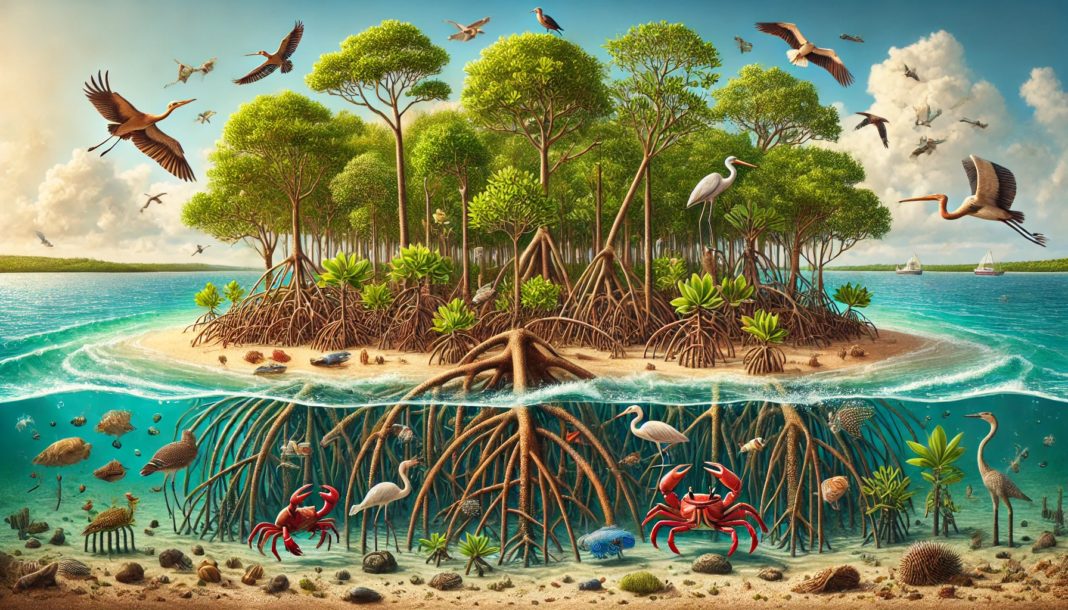Mangroves are vital components of coastal ecosystems in the Caribbean, providing a range of ecological services and supporting diverse wildlife.
These unique trees and shrubs thrive in the brackish water along coastlines, estuaries, and river mouths, where they play critical roles in coastal protection, biodiversity support, and carbon sequestration.
This article explores the significance of mangroves in the Caribbean, highlighting their ecological importance and the biodiversity they sustain.
The Ecological Importance of Mangroves
Coastal Protection
Mangroves act as natural barriers against coastal erosion, storm surges, and tsunamis. Their dense root systems stabilize the shoreline by trapping sediments and reducing wave energy. The roots of mangroves, including prop roots and pneumatophores, help anchor the soil, preventing it from being washed away by tidal forces. During storms and hurricanes, mangroves can significantly reduce the impact of high waves and flooding, protecting inland areas and human settlements.
Carbon Sequestration
Mangroves are among the most carbon-rich forests in the world. They sequester large amounts of carbon dioxide from the atmosphere, storing it in their biomass and the soil. This process, known as blue carbon, is crucial for mitigating climate change. The carbon stored in mangrove ecosystems can remain sequestered for centuries, making them essential components in the global carbon cycle.
Water Filtration and Nutrient Cycling
Mangroves play a key role in maintaining water quality in coastal areas. They act as natural filters, trapping pollutants, heavy metals, and nutrients from terrestrial runoff. The complex root systems slow down water flow, allowing sediments to settle and preventing these substances from reaching coral reefs and seagrass beds. Additionally, mangroves contribute to nutrient cycling by decomposing organic matter, which supports primary production and sustains food webs.
Unique Biodiversity of Mangrove Ecosystems
Mangroves provide critical habitats for a wide range of plant and animal species, many of which are endemic or specialized for life in these environments. The unique conditions created by the mix of saltwater and freshwater, along with the protection offered by the root systems, make mangroves vital nurseries for various species.
Marine Life
Mangroves are essential nurseries for many marine species, including fish, crustaceans, and mollusks. Young fish and other organisms find shelter among the roots, where they are protected from predators and have abundant food sources. Some notable species found in Caribbean mangroves include:
- Mangrove Snapper (Lutjanus griseus): A popular fish among anglers, it spends its juvenile stages in mangrove habitats.
- Blue Land Crab (Cardisoma guanhumi): Often found in the brackish waters of mangroves, this species plays a role in the ecosystem’s nutrient cycling.
- Juvenile Sharks: Species like lemon sharks use mangrove areas as nurseries, where the shallow waters offer protection from larger predators.
Birds
Mangroves are also crucial for avian species, providing nesting sites and feeding grounds. Many bird species rely on the abundant food resources available in these ecosystems. Some of the birds commonly found in Caribbean mangroves include:
- Great Egret (Ardea alba): This large white bird is often seen wading in the shallow waters, hunting for fish and invertebrates.
- Brown Pelican (Pelecanus occidentalis): Known for its distinctive diving behavior, the brown pelican frequently nests in mangrove trees.
- Yellow Warbler (Setophaga petechia): This small, vibrant bird is often found in mangrove habitats, where it feeds on insects and spiders.
Plants
Mangrove forests are composed of a variety of mangrove tree species, each adapted to the challenging conditions of brackish water and tidal fluctuations. Key species in the Caribbean include:
- Red Mangrove (Rhizophora mangle): Known for its distinctive prop roots, this species is often found closest to the water’s edge.
- Black Mangrove (Avicennia germinans): Characterized by pneumatophores, or aerial roots, that help the tree breathe in waterlogged soils.
- White Mangrove (Laguncularia racemosa): Typically found in slightly higher elevations, this species has peg roots and smooth, oval leaves.
Conservation Challenges and Efforts
Despite their ecological importance, mangroves face numerous threats, including deforestation, coastal development, pollution, and climate change. The loss of mangroves not only threatens the biodiversity they support but also diminishes their role in coastal protection and carbon sequestration.
Conservation efforts are crucial to preserving these valuable ecosystems. Initiatives such as establishing protected areas, restoring degraded mangrove forests, and promoting sustainable land-use practices are essential steps toward safeguarding mangroves. Additionally, raising awareness about the ecological and economic benefits of mangroves can help garner support for their conservation.
Conclusion
Mangroves are invaluable ecosystems that provide essential services, from protecting coastlines to supporting diverse species. In the Caribbean, these unique habitats are a cornerstone of the region’s natural heritage, offering a glimpse into the rich biodiversity and complex ecological processes that define this tropical paradise. Protecting and preserving mangroves is not only vital for maintaining the health of coastal ecosystems but also for ensuring the well-being of the communities that depend on them.
Frequently Asked Questions
What are the main threats to mangroves in the Caribbean?
The primary threats to mangroves in the Caribbean include deforestation for coastal development, pollution from agricultural and industrial activities, and climate change impacts such as sea-level rise and increased storm frequency. These factors contribute to habitat loss and degradation.
How do mangroves contribute to climate change mitigation?
Mangroves contribute to climate change mitigation by sequestering large amounts of carbon dioxide from the atmosphere. Their dense biomass and root systems store carbon in the form of organic matter, which can remain trapped in the soil for centuries. This process helps reduce the amount of greenhouse gases in the atmosphere.
Why are mangroves important for coastal protection?
Mangroves are important for coastal protection because their complex root systems reduce wave energy and trap sediments, preventing coastal erosion. During storms and hurricanes, mangroves act as natural buffers, absorbing the impact of waves and reducing the risk of flooding in inland areas.
What species are commonly found in Caribbean mangrove ecosystems?
Caribbean mangrove ecosystems are home to a variety of species, including the red mangrove, black mangrove, and white mangrove trees. These habitats also support diverse wildlife, such as the mangrove snapper, blue land crab, great egret, and brown pelican, as well as various fish, crustaceans, and birds.
How can we help protect mangroves in the Caribbean?
Protecting mangroves in the Caribbean involves supporting conservation efforts, such as establishing marine protected areas, participating in mangrove restoration projects, and promoting sustainable coastal development. Additionally, raising awareness about the ecological importance of mangroves and advocating for policies that protect these ecosystems are crucial steps.

